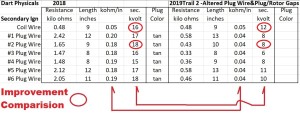Engine & Secondary Ignition Physical Part 4 restoration article is inspired by the soon and fast approaching May 2019 “Tech Event” being hosted by the Nichols at their home.
Part 1 covered the need for having ignition data on your unique vintage car, getting a routine “physical” to collect present data, & finally delved into some secondary ignition resistances.
Part 2 covered the importance of inspecting Secondary voltages & one cause of excess voltage.
Part 3 covered applying this knowledge to an example; 65 Dart (Slant Six) with excess secondary voltage measured in the 2018 Engine Secondary Ignition Physical. The 2019 65 Dart Ignition Physical was performed (Trail 1) after altering the design of the spark plug wires by changing plug wire types and achieving (only) a 10% improvement in Plug Wire Voltage.
Part 4 looks at two other suspected areas: plug resistance & distributor cap/rotor resistance. Since plug wire voltage was still too high after the plug wire design change & coil wire voltage is showing increases even though plug wire resistances had dropped……changes were needed.
The 65 Dart Ignition 2019 Physical (Trail 2) combines the effects of changing wire types, lowering plug gaps, & reducing distributor terminal to rotor gaps. Studying voltages at the coil wire & spark plug wires showed the very positive results with noticeable idle RPM increase. In general plug wire voltage dropped in half and coil wire voltage to about 70% of 2018 values:
Details included plug gaps being lowered from .038” to .033”. The details on the distributor cap/rotor gaps were that the cap/rotor gaps were lowered from .035” to .025” on average.
Coil wire voltages & plug wire voltages are closer to normal for this car so ignition component reliability is likely improved. These new values will be the expectation going forward for all future Secondary Voltage Physicals. Time to continue the 2019 Physical for other engine areas.
A future restoration article on lowering distributor terminal to rotor gaps will be covered under “distributor cap quality”. Hint-after testing more than 2 dozen caps my conclusion is old vintage cap/rotor resistances are lower than readily available current day newly made caps.
Vector Files for the above content are as follows:

